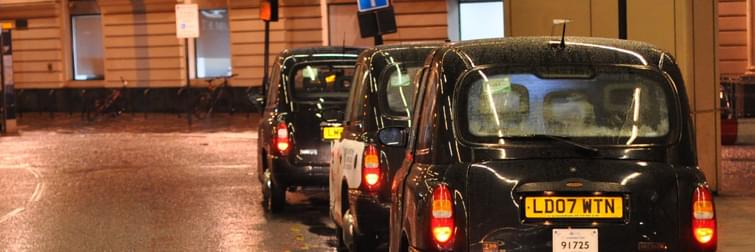
blog: Making the case for taxi accessibility
Wednesday 10th January 2018
The taxi has long been the poor relation of the urban transport network. Its uniquely high responsiveness to demand ensures that its ability to function effectively is less implicated by the way it is planned for; relative to other modes of travel. The role of the taxi has traditionally been to plug the gaps in the transport network that more strategic modes cannot fill. As such it has largely occupied an auxiliary function and sat towards the bottom of the travel mode hierarchy.
Typically, taxis in urban areas are viewed as ‘last-mile’ connectors, or as premium seamless door-to-door services. However, the role of taxis in promoting social inclusion in cities has often been underappreciated, specifically for their capability to serve the needs of people who experience reduced mobility. It is not the absence or infrequency of alternative modes in cities – as is often the case in rural areas – that promotes the inclusionary function of the taxi; but instead the relative inaccessibility of the alternative options.
Transport for London has committed significant investment to improving accessibility across its public transport network over recent years. But public transport modes themselves are by no means perfectly accessible, nor can they all be made so in the context of trying to operate a fast, high-capacity public transport network that provides a genuine alternative to private car use. Buses, for instance, are characterised by stop-starting motion and standing room only at peak times. Similarly, London’s underground and rail networks suffer from overcrowding, while 100% step-free access is inhibited by the challenge and cost of overcoming legacy engineering constraints.
While making accessibility improvements across the piece, is vital to promoting a public transport system that works for as many people as possible. There will always be those whose level of mobility is such they cannot use public transport, or who do not feel they can rely upon it to get around.
For such people, the ability to access independent mobility modes - like a taxi - can be the difference between being 'marooned' at home and having the option to access a range of stimulating lifestyle opportunities and activities that many non-disabled people routinely take for granted.
In order to ensure the taxi industry is set up to respond to the needs of people with reduced mobility, policy-makers and regulators have to put the requisite policies and standards in place to support everyone. Taxi operators may not possess the commercial incentives through the market to invest in such provisions themselves.
Firstly, this mandates placing minimum standards of compliance on vehicle specifications to ensure that they can, for instance; safely accommodate wheelchair users, ensure people with hearing impairments can communicate with the driver, and provide access/entry/seating arrangements that suit a range of dexterity, agility and comfort needs. Such policies can also require drivers to avail themselves of the appropriate assistance and disability awareness training to ensure they have the skills needed to provide assistance to passengers with specific needs, while ensuring they are treated with respect and dignity. Finally, it involves ensuring the fixed infrastructure, such as the taxi ranks and associated environments, are well-designed for the wide range of needs described above. Perhaps surprisingly, the final point remains a challenge in many cities today and reflects an initial onus on vehicle standards and driver training.
The limiting factor in the design of taxi infrastructure in many cities is that taxis fall behind buses, pedestrians and cyclists in the travel mode hierarchy, and can sometimes be an afterthought in respect of how the movement function of streets is designed. Taxi infrastructure therefore frequently gets outcompeted in the ongoing struggle for kerbside space. This is particularly true at locations other than major transport interchanges, which can result in sub-optimal solutions. There is a tendency to either shoehorn infrastructure in or to omit/overlook facilities such as taxi ranks entirely at lower-order trip attractors.
This is counter-intuitive, given the people who experience the greatest mobility restrictions also often rely more heavily on taxi services than other options. As such the accessibility argument presents a case for prioritising the design and improvement of taxi infrastructure on par with that required to facilitate other travel modes.
This may require something of a change in design philosophy going forward, and one predicated upon a change in the perception of the taxi 'product' amongst urban designers and policy-makers. Fundamentally, this involves considering taxis as a strategic rather than an auxiliary component of the transport system - a need rather than a nuisance.
If you are interested to learn more about designing for taxis in urban environments, including the work that ITP has led in London, please contact Neil Taylor, a Director at ITP on taylor@itpworld.net.
